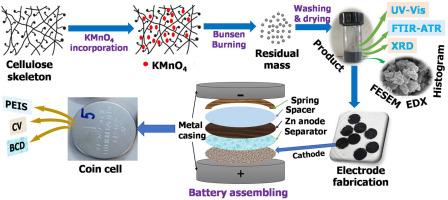利用纤维素骨架诱导二氧化锰生产锌离子电池的环保型正极材料:物理化学、形态学和电化学研究
IF 6.2
Q1 CHEMISTRY, APPLIED
Carbohydrate Polymer Technologies and Applications
Pub Date : 2024-10-05
DOI:10.1016/j.carpta.2024.100583
引用次数: 0
摘要
能源安全是一个普遍问题,因为现代文明一刻也离不开能源。尽管化石燃料主要用于满足当前的能源需求,但这些燃料会对环境造成不利影响。各种储能技术可以以可持续的生态友好方式解决这一问题。可充电锌离子电池(ZIBs)具有多种优势,正在成为满足日益增长的商业需求的潜在候选产品。作为其中的一部分,我们采用创新路线制备了纤维素骨架诱导的二氧化锰基电活性阴极材料,并使用紫外可见-近红外光谱、傅立叶变换红外光谱、外聚焦电子显微镜、电致发光分析和 X 射线衍射分析对其进行了表征。结果表明,新制备的环保型阴极材料具有出色的物理化学、形态和结构特性。成品(即 ZIBs 的纽扣电池)在 PEIS 中显示出良好的 CV 曲线和最小的电荷转移电阻。值得注意的是,新制备的阴极材料在 5 mA 恒定电流充放电速率下也显示出 29 mAhg-1 的显著容量。因此,虽然这种方法还存在一些缺点,但由于其环保性,可用于储能设备中。循环稳定性略低,有待进一步研究提高。本文章由计算机程序翻译,如有差异,请以英文原文为准。

Production of eco-friendly cathode materials from cellulose skeleton induced manganese dioxide to produce zinc ion battery: Physicochemical, morphological, and electrochemical study
Energy security is a universal issue since modern civilization cannot be imagined for a single moment without energy. Though lean fossil fuels are fighting against the current energy demand principally, these are linked to adverse environmental effects. Various energy storage technologies can resolve this issue in a sustainable eco-friendly manner. Rechargeable Zn-ion batteries (ZIBs) are emerging as potential candidates to meet the growing commercial demand with several advantages. As a part of this, the cellulose skeleton-induced manganese dioxide-based electroactive cathode materials have been prepared by an innovative route and characterized using UV–vis-NIR, FTIR, FESEM, EDS, and XRD analysis. Results suggested that the newly produced eco-friendly cathode materials have possessed outstanding physicochemical, morphological, and structural properties. While the finished product namely the coin cell of ZIBs has shown a good CV profile along with minimal charge transfer resistance in PEIS. Noteworthy that the newly prepared cathode materials have also been shown a significant capacity of 29 mAhg-1 at a 5 mA constant current charge-discharge rate. Thus, the method could be beneficially used in energy storage devices for its eco-friendly nature though some drawbacks have been noticed. The cyclic stabilities were somewhat low which can be increased in further studies.
求助全文
通过发布文献求助,成功后即可免费获取论文全文。
去求助

 求助内容:
求助内容: 应助结果提醒方式:
应助结果提醒方式:


